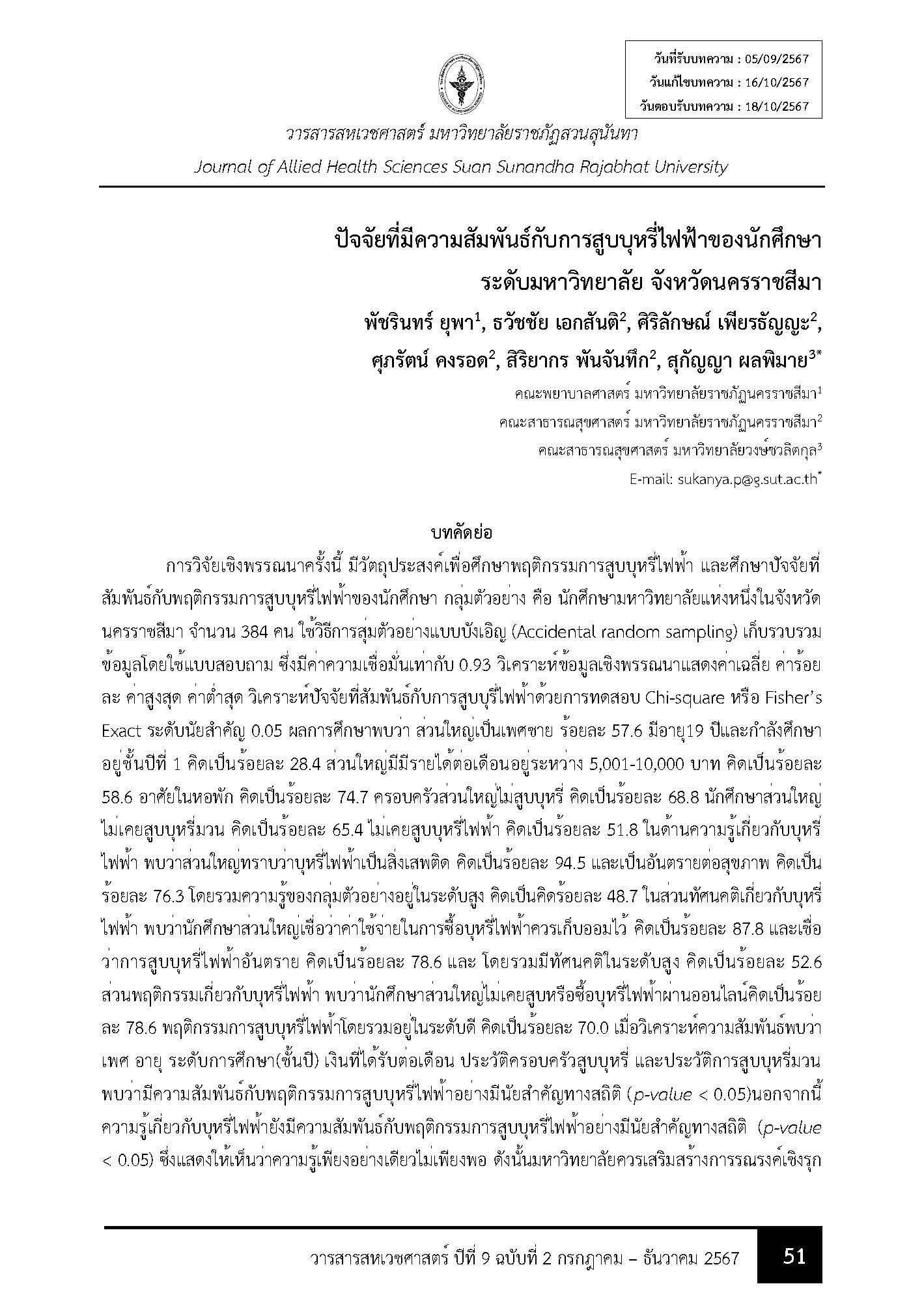Factors related to the use of electronic cigarettes among university students in Nakhon Ratchasima Province
Main Article Content
Abstract
This descriptive research aimed to study the behavior of electronic cigarette (e-cigarette) use and the factors associated with e-cigarette smoking behavior among university students. The sample consisted of 384 students from a university in Nakhon Ratchasima province, selected through accidental random sampling. Data were collected using a questionnaire with a reliability score of 0.93. Descriptive data were analyzed using mean, percentage, maximum, and minimum values, while factors related to e-cigarette smoking were analyzed using the Chi-square or Fisher’s Exact test at a significance level of 0.05. The results showed that the majority of the participants were male (57.6%) and 19 years old, with most of them being first-year students (28.4%). A large proportion (58.6%) had a monthly income between 5,001-10,000 Baht, and 74.7% lived in dormitories. Most participants reported that their family members did not smoke (68.8%), 65.4% had never smoked traditional cigarettes, and 51.8% had never used e-cigarettes. Regarding knowledge about e-cigarettes, the majority (94.5%) knew that e-cigarettes are addictive and harmful to health (76.3%). Overall, 48.7% of the participants had a high level of knowledge about e-cigarettes. In terms of attitudes toward e-cigarettes, 87.8% believed that money spent on e-cigarettes should be saved, and a significant percentage believed that e-cigarette smoking is dangerous (78.6%). Overall, 52.6% of the participants had a high level of attitude toward e-cigarettes. Regarding e-cigarette-related behavior, 78.6% had never smoked or purchased e-cigarettes online, and overall, 70% demonstrated good e-cigarette-related behavior. The analysis revealed that gender, age, education level (year of study), monthly income, family smoking history, and traditional cigarette smoking history were significantly associated with e-cigarette smoking behavior (p-value < 0.05). Additionally, knowledge about e-cigarettes was significantly related to e-cigarette smoking behavior (p-value < 0.05), indicating that knowledge alone is insufficient. Therefore, the university should strengthen proactive campaigns focusing on preventing e-cigarette use among students, emphasizing financial management education and good spending habits, with support from family members, psychologists, and health professionals. Additionally, creating a safe and health-promoting environment on campus, such as establishing a smoke-free university, is recommended.
Article Details
References
ชนิกา เจริญจิตต์กุล, ชฎาภา ประเสริฐทรง. บุหรี่ไฟฟ้า : ภัยเงียบของวัยรุ่น. วารสารพยาบาลทหารบก. 2557;15(3):149-54
นัฐวดี อาระสา, ฉวีวรรณ บุญสุยา, และวศิน พิพัฒนฉัตร.การสูบบุหรี่และปัจจัยที่เกี่ยวข้องของเยาวชนในสถานศึกษา. วารสารควบคุมโรค. 2567;50(1):137–147. https://doi.org/10.14456/ dcj.2024.12
สำนักงานกองทุนสนับสนุนการสร้างเสริมสุขภาพ. WHO ออกแถลงการณ์คุมเข้มบุหรี่ไฟฟ้า [อินเทอร์เน็ต]. 2023 [เข้าถึงเมื่อ 9 ส.ค. 2024]. เข้าถึงได้จาก: https://shorturl.asia/pKORt
ศรีรัช ลอยสมุทร. ผลิตภัณฑ์ยาสูบรูปแบบใหม่ในสื่อสังคมเครือข่ายและผลของการบังคับใช้กฎหมายผลิตภัณฑ์ยาสูบรูปแบบใหม่. วารสารกฎหมายสุขภาพและสาธารณสุข. 2562;5(1):13-29
Pepper J, Reiter P, McRee A, Cameron L, Gilkey M, Brewer N. Adolescent males' awareness of and willingness to try electronic cigarettes. J Adolesc Health. 2013 Feb;52(2): 144-50. doi: 10.1016/j.jadohealth. 2012.09.014
Sutfin E, McCoy T, Morrell H, Hoeppner B, Wolfson M. Electronic cigarette use by college students. Drug Alcohol Depend. 2013 Aug 1;131(3):214-21. doi: 10.1016/ j.drugalcdep.2013.05.001
Regan A, Promoff G, Dube S, Arrazola R. Electronic nicotine delivery systems: adult use and awareness of the 'e-cigarette' in the USA. Tob Control. 2013 Jan;22(1):19-23. doi: 10.1136/tobaccocontrol-2011-050044
Cochran W. Sampling Technique. 2nd Edition. New York: John Wiley and Sons Inc.; 1963
ศศิธร ชิดนายี และวราภรณ์ ยศทวี.ปัจจัยที่มีความสัมพันธ์กับพฤติกรรมการสูบบุหรี่ของวัยรุ่นจังหวัดอุตรดิตถ์.วารสารวิทยาลัยพยาบาลบรมราชชนนี อุตรดิตถ์. 2561;10(1):83-93
ยสินทร มีกูล, อรนภา ล่ำปิยะ, วุฒิฌาน ห้วยทราย. ปัจจัยที่มีความสัมพันธ์กับพฤติกรรมการสูบบุหรี่ของนักศึกษามหาวิทยาลัยอุบลราชธานี. วารสารสาธารณสุขล้านนา. 2566;19(1):76-88
ปิยวรรณ บุญเพ็ญ, ภาวนา เมนทะระ, ปิยชาติ บุญเพ็ญ. พฤติกรรมการสูบบุหรี่ไฟฟ้าและพฤติกรรมต้องการเลิกบุหรี่ของนักศึกษาระดับอุดมศึกษาในเขตกรุงเทพมหานคร. วารสารศรีนครินทรวิโรฒวิจัยและพัฒนา. 2562;11(22):111-27
กัลยา วิริยะ, ประภาพร ชูกำเหนิด, อังศุมา อภิชาโต. ความรู้และทัศนคติเกี่ยวกับบุหรี่กับพฤติกรรมการสัมผัสบุหรี่ของนักศึกษามหาวิทยาลัยสงขลานครินทร์. วารสารวิทยาบริการ มหาวิทยาลัยสงขลานครินทร์. 2562;30(1): 66-74

